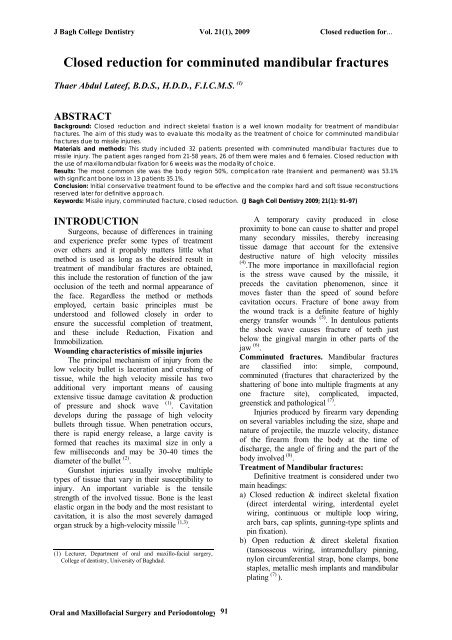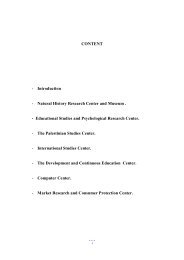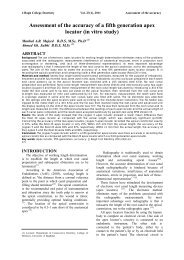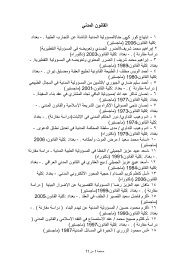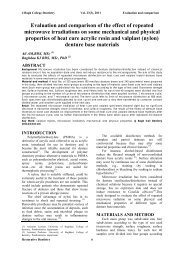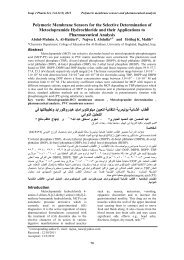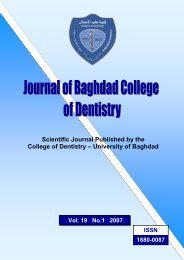Vol 21 No. 1
Vol 21 No. 1
Vol 21 No. 1
You also want an ePaper? Increase the reach of your titles
YUMPU automatically turns print PDFs into web optimized ePapers that Google loves.
J Bagh College Dentistry <strong>Vol</strong>. <strong>21</strong>(1), 2009 Closed reduction for...<br />
Closed reduction for comminuted mandibular fractures<br />
Thaer Abdul Lateef, B.D.S., H.D.D., F.I.C.M.S. (1)<br />
ABSTRACT<br />
Background: Closed reduction and indirect skeletal fixation is a well known modality for treatment of mandibular<br />
fractures. The aim of this study was to evaluate this modality as the treatment of choice for comminuted mandibular<br />
fractures due to missile injuries.<br />
Materials and methods: This study included 32 patients presented with comminuted mandibular fractures due to<br />
missile injury. The patient ages ranged from <strong>21</strong>-58 years, 26 of them were males and 6 females. Closed reduction with<br />
the use of maxillomandbular fixation for 6 weeks was the modality of choice.<br />
Results: The most common site was the body region 50%, complication rate (transient and permanent) was 53.1%<br />
with significant bone loss in 13 patients 35.1%.<br />
Conclusion: Initial conservative treatment found to be effective and the complex hard and soft tissue reconstructions<br />
reserved later for definitive approach.<br />
Keywords: Missile injury, comminuted fracture, closed reduction. (J Bagh Coll Dentistry 2009; <strong>21</strong>(1): 91-97)<br />
INTRODUCTION<br />
Surgeons, because of differences in training<br />
and experience prefer some types of treatment<br />
over others and it propably matters little what<br />
method is used as long as the desired result in<br />
treatment of mandibular fractures are obtained,<br />
this include the restoration of function of the jaw<br />
occlusion of the teeth and normal appearance of<br />
the face. Regardless the method or methods<br />
employed, certain basic principles must be<br />
understood and followed closely in order to<br />
ensure the successful completion of treatment,<br />
and these include Reduction, Fixation and<br />
Immobilization.<br />
Wounding characteristics of missile injuries<br />
The principal mechanism of injury from the<br />
low velocity bullet is laceration and crushing of<br />
tissue, while the high velocity missile has two<br />
additional very important means of causing<br />
extensive tissue damage cavitation & production<br />
of pressure and shock wave<br />
(1) . Cavitation<br />
develops during the passage of high velocity<br />
bullets through tissue. When penetration occurs,<br />
there is rapid energy release, a large cavity is<br />
formed that reaches its maximal size in only a<br />
few milliseconds and may be 30-40 times the<br />
diameter of the bullet (2) .<br />
Gunshot injuries usually involve multiple<br />
types of tissue that vary in their susceptibility to<br />
injury. An important variable is the tensile<br />
strength of the involved tissue. Bone is the least<br />
elastic organ in the body and the most resistant to<br />
cavitation, it is also the most severely damaged<br />
organ struck by a high-velocity missile (1,3) .<br />
(1) Lecturer, Department of oral and maxillo-facial surgery,<br />
College of dentistry, University of Baghdad.<br />
A temporary cavity produced in close<br />
proximity to bone can cause to shatter and propel<br />
many secondary missiles, thereby increasing<br />
tissue damage that account for the extensive<br />
destructive nature of high velocity missiles<br />
(4) .The more importance in maxillofacial region<br />
is the stress wave caused by the missile, it<br />
preceds the cavitation phenomenon, since it<br />
moves faster than the speed of sound before<br />
cavitation occurs. Fracture of bone away from<br />
the wound track is a definite feature of highly<br />
energy transfer wounds (5) . In dentulous patients<br />
the shock wave causes fracture of teeth just<br />
below the gingival margin in other parts of the<br />
jaw (6) .<br />
Comminuted fractures. Mandibular fractures<br />
are classified into: simple, compound,<br />
comminuted (fractures that characterized by the<br />
shattering of bone into multiple fragments at any<br />
one fracture site), complicated, impacted,<br />
greenstick and pathological (7) .<br />
Injuries produced by firearm vary depending<br />
on several variables including the size, shape and<br />
nature of projectile, the muzzle velocity, distance<br />
of the firearm from the body at the time of<br />
discharge, the angle of firing and the part of the<br />
body involved (8) .<br />
Treatment of Mandibular fractures:<br />
Definitive treatment is considered under two<br />
main headings:<br />
a) Closed reduction & indirect skeletal fixation<br />
(direct interdental wiring, interdental eyelet<br />
wiring, continuous or multiple loop wiring,<br />
arch bars, cap splints, gunning-type splints and<br />
pin fixation).<br />
b) Open reduction & direct skeletal fixation<br />
(tansosseous wiring, intramedullary pinning,<br />
nylon circumferential strap, bone clamps, bone<br />
staples, metallic mesh implants and mandibular<br />
plating (7) ).<br />
Oral and Maxillofacial Surgery and Periodontology 91


